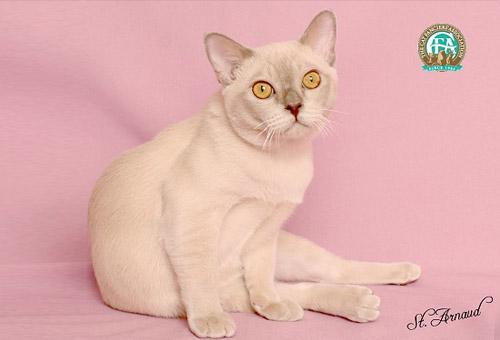


 Pictured: Second Best of Breed GC, RW BAJIMBI CREME KINSMEN OF PENOBSCOT, Cream European Burmese Male Photo: © Larry Johnson The solids were selected for further propagation of the breed. From the United States the breed spread east to the United Kingdom where the same lack of breeding stock led again to the introduction of Siamese. From then on the breed followed different courses of development until today we have two very different looking cats with two different standards both sharing a common ancestry. The most obvious difference is the array of colors displayed by the European Burmese - ten to be exact. Introduction of the red gene is esponsible for the additional colors. This gene was introduced both deliberately and by accident. In the U.K. Siamese come in many colors including red points, so the introduction of this gene to the existing four colors (brown, chocolate, blue and lilac) produced the colors red, cream, brown-tortie, chocolatetortie, blue-tortie and lilac-tortie. There is also a difference in type between the two Burmese breeds. The European Burmese is an elegant, moderate cat with gently rounded contours, whereas the Burmese has a compact, well-rounded appearance. The eye shape differs between the two breeds. The European Burmese should have eyes with a top line that is slightly curved with a slant towards the nose. The lower line should be rounded. The Burmese eyes should have a rounded aperture. The temperament of the two Burmese breeds is essentially the same.
The European Burmese is an elegant but not a fragile cat. It is of sweet disposition, medium size, solid boning, excellent musculature and expressive eyes. Because the European Burmese are highly intelligent, affectionate and extremely loyal, they make outstanding pets. They like the companionship of another animal, being dog or cat; however, if circumstances make it impossible they will live quite happily as the sole pet. They love people and make wonderful companions. Pricing on European Burmese usually depends on type, applicable markings and bloodlines distinguished by Grand Champion (GC), National Regional winning parentage (NW or RW) or of Distinguished Merit parentage (DM). The DM title is achieved by the dam (mother) having produced five CFA grand champion/premier (alter) or DM offspring, or sire (father) having produced fifteen CFA grand champion/premier or DM offspring. Usually breeders make kittens available between twelve and sixteen weeks of age. After twelve weeks, kittens have had their basic inoculations and developed the physical and social stability needed for a new environment, showing, or being transported by air. Keeping such a rare treasure indoors, neutering or spaying and providing acceptable surfaces (e.g. scratching posts) for the natural behavior of scratching (CFA disapproves of declawing or tendonectomy surgery) are essential elements for maintaining a healthy, long and joyful life. There are CFA clubs devoted to the promotion, protection and preservation of the European Burmese breed. For more information, please send inquiries to CFA at cfa@cfa.org. Text: European Burmese Breed Council Last Updated: Friday, June 18, 2010
|